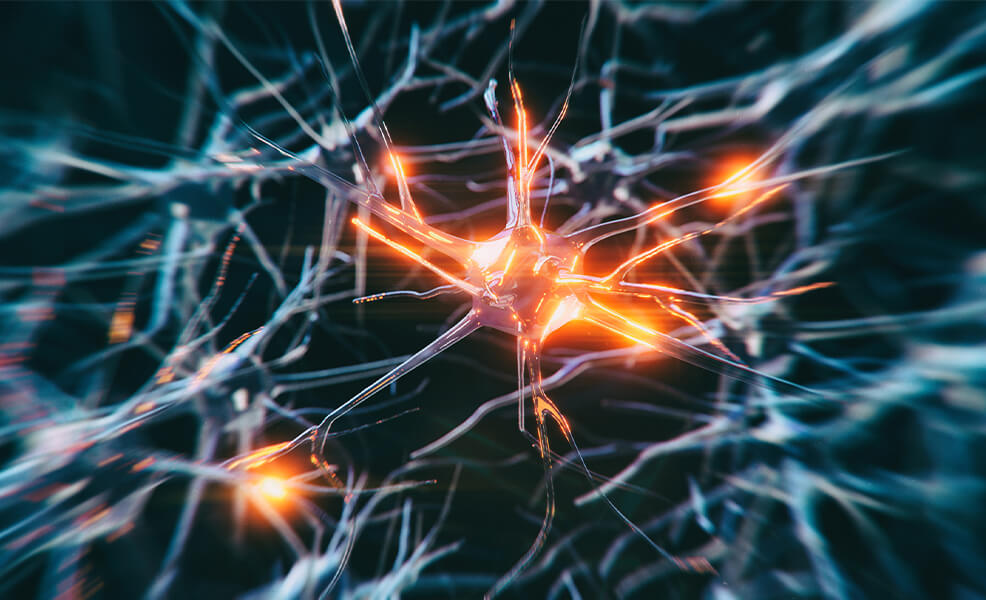
A trapped nerve, also commonly referred to as a ‘pinched’ nerve, is often a very painful condition in which a nerve experiences pressure or gets compressed. This pressure usually comes from the surrounding tissues, including bones, muscles, cartilage and tendons, due to postural issues, bulging disc (in the lower back), poor posture or Repetitive Strain Injury (RSI).
As a result, the nerve roots become inflamed or injured, causing pain, tingling or numbness. This can occur anywhere in the body.
In most cases, pain from a trapped nerve can be temporary. As soon as the pressure on a trapped nerve is released, the inflammation eases on its own with rest. It may take a few days or weeks. However, the pain from a trapped nerve in the neck, back and shoulder can become severe and long lasting if not treated early.
One good example is a compressed or trapped nerve in the neck caused by a bulging disc or spondylosis. It causes pain or numbness in the neck, shoulders and between the shoulder blades. This, without prompt medical or physical therapy, can become a chronic condition. In some cases it may even cause permanent nerve damage.
The following are the most common areas to experience the effects of a trapped nerve frequently:
- Lower back and leg (trapped lumbar nerves)
- Neck and shoulder (trapped cervical nerves)
- Wrist and hand (carpal tunnel syndrome-trapped median nerve)
- Forearms (trapped radial nerve)
- Arms and elbow (pressure on the ulnar nerve)
Symptoms of a Trapped Nerve

- Sharp radiating pain or a dull ache
- Numbness or reduced sensation
- Tingling (typically, pins and needles tingling)
- Muscle weakness
- A feeling that your hand or foot has fallen asleep, in medical terms this called temporary paraesthesia
Causes of a Trapped Nerve
We know that a trapped nerve occurs when the surrounding tissues compress it. Here are some of the conditions that possibly compress a nerve root.
- Rheumatoid arthritis: The inflammation caused by rheumatoid arthritis, especially in the joints and spine, can compress nearby nerves
- Bone Spurs: Bone damage caused by osteoarthritis can form bone spurs over time and may compress the spinal root nerves
- Herniated disc: When a fragment of the disc nucleus pushes out into the spinal cord, it compresses the nearby spinal root nerve. A trapped nerve from a herniated disc usually occurs in the lower back of the spine, the lumbar region. This pain spreads down to the leg. E.g the leg pain from a pinched nerve at the level of L4/L5 or L5/S1 is often called Sciatica.
- Degenerated disc: The inflammation caused by degenerated disc also compresses nearby nerves. How does this happen? Well degenerated disc may cause deflation and ‘shrinkage’ of the disc which in turn may decrease the space through which the nerve roots exit to their different pathways.
- Spondylosis: A trapped nerve in the neck and back occurs when the space needed by nerve roots that pass through the spine become narrow. This often occurs in Spondylosis
- Spinal stenosis: This condition also reduces the space for nerves, pressing them and causing a trapped nerve in the back. Usually this type of Spinal Stenosis is termed peripheral spinal stenosis. A patient may find when he or she bends forward the symptoms of a trapped nerve ease.

Other causes of a trapped nerve are:
- Sports injuries or fractures from an accident
- Poor posture
- Obesity
- Repetitive Stress Injury (RSI)
- Poor Technique during Weight Training
- Diabetes
- Prolonged bed rest
- Pregnancy
- Masses/tumours
Diagnosis of a Trapped Nerve
You can’t exactly tell if a pain in your neck, shoulder or leg is due to a trapped nerve. So if any unexplainable or burning pain continues for several days, even after rest and conservative treatments, you will have to visit a doctor.
Your doctor will begin with a thorough medical history, including exploring the site, duration and nature of the pain. A physical examination follows, where your doctor may check the area where your pain persists— to find the source of a trapped nerve
For a more accurate diagnosis of a trapped nerve in the shoulder or a trapped nerve in the neck or back, your doctor may ask for imaging tests. Generally, MRI scan or Nerve Conductions studies is performed to locate and find the cause of nerve compression.
In some joints i.e the wrist, ultrasound may be used to look for median nerve compression.
Treatment for a Trapped Nerve
If your symptoms do not improve with rest, your doctor may recommend some of the following treatments. They may also suggest wearing splints and cervical collars to limit movements while healing. Just a note that, when it comes to treatment, the sooner you visit a doctor, the faster you recover.
If pain from a trapped nerve is treated inadequately the phenomenon of central sensitisation can occur, this is when the pain becomes chronic and much harder to treat later
Unfortunately with current delays in the NHS, getting prompt treatment or investigations for a trapped nerve is not always easy, and can depend on the region of the UK you reside in as well as the services commissioned by the NHS in that particular region.
Therefore we highly recommend seeing a clinician privately if you suspect you are suffering from the symptoms of a trapped nerve. A doctor, chiropractor, osteopath or physio are all suitable professionals who can be consulted for this condition
Analgesics
The pain and inflammation can be eased off with many non-steroidal anti-inflammatory drugs (NSAIDs) such as Ibuprofen and naproxen.
Injections
Cortisone injections and epidural steroid injections also help relieve the pain and inflammation from a trapped nerve in Sciatica
Physical Therapy
Mild stretches and specific exercises help ease the pressure from a trapped nerve and provide some relief from pain.
Massage
If soft tissues cause a trapped nerve, massage therapy can relax the muscles which may become very painful and ease the symptoms effectively.
Surgery
Surgery is the last resort to cure a trapped nerve in the shoulder, back and neck. Some invasive procedures include Discectomy and nerve decompression. Full recovery after surgery takes a few weeks to months, depending upon your medical condition.
Final Thoughts
A trapped nerve is a common condition and occurs in people of all ages. Though you can’t always prevent it, there are still many treatment options.
FAQ’s
What is radial tunnel syndrome?
Radial tunnel syndrome is a condition caused by pressure on the radial nerve that runs to your forearm from the neck. A trapped radial nerve causes pain and weakness in your forearm and hands. Without proper treatment, the pain gets worse over time and affects the movement of your wrist, elbow and forearm.
How to cure a trapped nerve in the neck?
Pain from the trapped nerve usually eases on its own within 4 weeks with rest. For mild symptoms, a hot or cold compress along with pain relief can help. Massage and physical therapy also help relieve the pain. If none of this works, please visit a doctor.
How long does it take for a trapped peroneal nerve to heal?
The peroneal nerve is one of the major nerves that travel to the leg and foot. The nerve becomes trapped when the fibrous passageway through which it passes becomes narrow, causing pain, tingling or numbness in the foot. If conditions do not improve with non-invasive treatment, surgery is performed to remove the pressure from the nerve. The recovery period usually is 4 to 6 weeks.
What is a trapped median nerve?
When the median nerve, one of the major nerves of the upper limb, is trapped or compressed, it causes pain in the hand, wrist and arm. This condition is called carpal tunnel syndrome. Wearing a splint and medication can help ease the pain caused by the trapped median nerve.
Can you treat a trapped nerve in the leg?
Yes, you can treat a trapped nerve in the leg with rest and other conservative treatments.
Stretches, physical therapy, massages help with your symptoms. Some people also get positive results with acupuncture.




